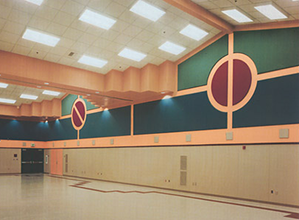Sound Absorption
Rooms with walls and ceilings made of hard surfaces often suffer from reverberation. Users of these rooms complain about echoes and inaudible speech. Examples of these rooms are gyms, multi-purpose rooms, and cafeterias. There are a number of ways you can reduce reverberation time in these types of rooms.
The idea behind sound absorption is to install soft items in a space with many hard surfaces to absorb some of the sound. Often these spaces are not well-suited to using carpet, so one has to look to the walls and ceilings for sound absorption opportunities.
Ceiling Sound Absorption
 A very common solution for ceiling absorption is hanging baffles or banners. These are lightweight, PVC wrapped panels that easily hand from the ceiling in a variety of configurations. They can be made to several sizes, the standard being 4′ x 2′, and are available in many colors. Some clients use white baffles to blend in with the ceiling as they are visually unobtrusive. Other clients use the opportunity to make colorful patterns with their baffles, such as using school colors.
A very common solution for ceiling absorption is hanging baffles or banners. These are lightweight, PVC wrapped panels that easily hand from the ceiling in a variety of configurations. They can be made to several sizes, the standard being 4′ x 2′, and are available in many colors. Some clients use white baffles to blend in with the ceiling as they are visually unobtrusive. Other clients use the opportunity to make colorful patterns with their baffles, such as using school colors.
We recommend calling a noise control professional to determine the appropriate quantity and size of baffles for your space. eNoise Control experts can help you make sure you have enough baffles or banners to effectively control the noise levels in your room.
Wall Sound Absorption
The most common wall absorption solution is a fabric wrapped panel. These are constructed of a fiberglass absorptive core and covered with an attractive fabric. A variety of fabric colors and styles are available to match your decorating needs. These hang easily on the wall and can make your space visually appealing while reducing sound reverberation.
Acoustic foam is also often used on walls to reduce noise. They come in several colors and are available in convoluted (egg-crate) and pyramid styles.

Acoustic Foam





